I’ve been privy to lots of interesting conversations about our most recent ALA winners this week. And since it’s Friday and we’re all now able to step back and take into account what all just happened, here is a quick summary of some of the discussions, topics, and random facts surrounding the Youth Media Awards of 2016. Just so that you’re playing along at home, here is the announcement of who the winners were. First up . . .
Newbery
We’ll begin with the most surprising choice. Last Stop on Market Street, a picture book, won the Newbery. The question was then whether or not it is the first picture book to win the award. After all, A Visit to William Blake’s Inn won back in 1982, yes? And it also won a Caldecott Honor, just like Market Street. Yet William Blake’s Inn was poetry first, and picture book second. Market Street is straight up picture book text, context, you name it. So, in some ways, it is the first award winner, yes.
Next, there was a question as to whether or not Matt de la Pena is the first Latino to win the Newbery Award (not Honor but Award). And it was Roger Sutton who pointed out that maybe not. Remember, if you will, Paula Fox. As he wrote, “from Augusta Baker’s profile of Fox, written for The Horn Book to accompany her Newbery speech in 1974: ‘Paula Fox knew her share of pain as a child. A New Yorker by birth, half-Spanish, half-Irish-English, she was sent at the age of eight to live with her grandmother in Cuba’.” This is not something I’d heard before. Thank you, Roger!
Jon Scieszka tweeted this during the week as well:
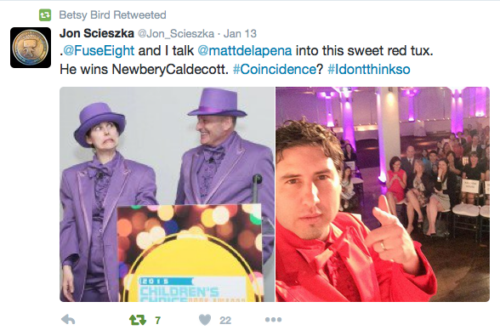
You can read more about that night here, if you like. My sole regret is that the evening wasn’t taped. Matt killed in that tux.
Moving on, while Matt may not be the first Latino Award winner of the Newbery, it is certainly true that 2016 was the first time that there was a Latino winner of the Award and a Latino winner of an Honor in the same year. Echo by Pam Munoz Ryan was an early favorite in 2015. I remember the book well and I also remember its swag. Many galleys were sent out with little harmonicas. In my office, just because of who works there, we received about four of five of these harmonicas. They were cute but we weren’t entirely certain what to do with them. Someone should write a middle grade called A Confusion of Harmonicas.

Someone should also tap Norton Juster to play a harmonica at the Newbery/Caldecott Banquet the way he did the year Raschka’s The Hello, Goodbye Window won a Caldecott.
Many were quite thrilled that The War That Saved My Life received recognition, including myself. You can find my review of it here. It was particularly gratifying since back in the day I wanted her to win an award for Jefferson’s Sons.
Roller Girl by Victoria Jamieson was a surprise win for many. If folks thought El Deafo‘s win last year was a fluke, Victoria’s latest Honor drills home that graphic novels are here to stay. It also means that the push for a separate Graphic Novel award may fall by the wayside. After all, they can apparently win Newberys now. For fun, take a trip in the wayback machine to 2009 when Victoria solicited cool children’s literature-related roller derby names on this site. My favorite remains Jacob Have I Shoved (with special honors going to Winnie-the-Pow!).
And speaking of Winnie . . .
Caldecott
I’m going to level with you. When I read Finding Winnie I had a lot to say about it. And though it was being published in October, I reviewed in May. I loved it so.
Sophie appeared at a Spring Little Brown & Company preview in early March of 2015 to talk about the book, as it happens. While doing so she showed a lot of the research she conducted for the art. Here are some of the tweets from that time:

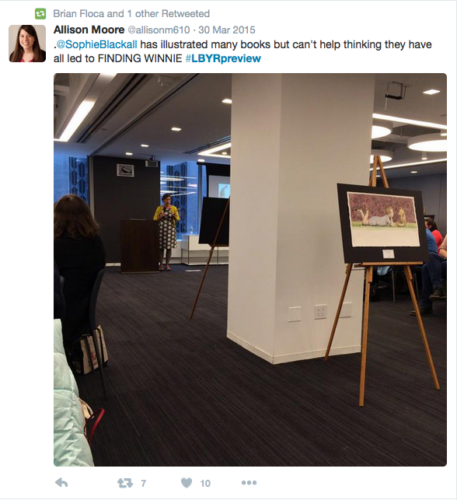
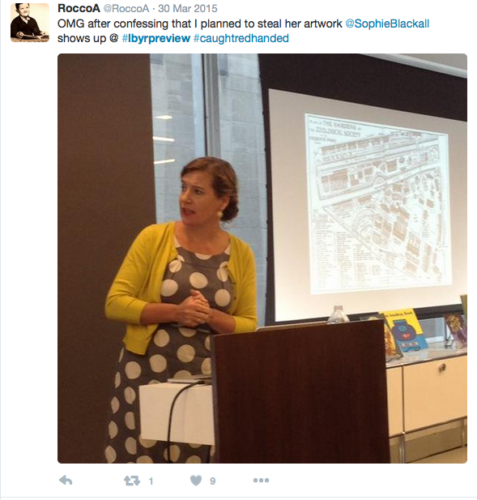
On his post on The Relative Surprise-iness of the 2016 Youth Media Awards, Travis Jonker points out that Trombone Shorty wasn’t one of those books that made it onto a lot Mock Award lists. Looking at the ALSC blog that collects these Mock Awards, it wasn’t shut out. The 43rd annual Caldecott Read-In was held on January 9th at the Main Library for the Toledo-Lucas County Public Library (Ohio) predicted its Honor. It was also the Award winner on December 21, 2015, when over 900 students in grades K-5 voted for the Mock Caldecott at Falmouth Elementary School in Falmouth, Maine. Well done to both!
Far more people were familiar with Voice of Freedom: Fannie Lou Hamer, Spirit of the Civil Rights Movement, illustrated by Ekua Holmes, written by Carole Boston Weatherford. Now there’s a book that could have won a Newbery as easily as a Caldecott as well. The writing is so superb. I’m happy to report that both this book AND Trombone Shorty appeared on New York Public Library’s 100 Books for Reading and Sharing list for the year as well. Those NYPL librarians. They’ve got their fingers on the pulse.
As for Waiting by Kevin Henkes, note this screenshot from a Harper Collins preview on December 29, 2014:

Nailed It! Or, to be more precise, Somewhat Nailed It! I wasn’t entirely off anyway.
Other awards were interesting as well. For example, the recent Printz Award winner spoke at LENGTH on this site about her soon-to-be-award winning book. Here, I’ll save you the trouble. Voila:
On the Coretta Scott King side of things, Rita Williams-Garcia was kind enough to talk about her book here:
For further final fun, do be so good as to read Travis Jonker’s post on as well as the reaction tweets. Also consider the Heavy Medal thoughts on the Newbery Award winner and their commenters thoughts on all the winners here. And Calling Caldecott did the same here.

In this guest post, Dr. Henrietta M. Smith, Professor Emerita and the first African-American professor at the University of South Florida, School of Information shares her memories of how the Coretta Scott King Award began:
The news of the damage sustained by the boardwalk in Atlantic City during Hurricane Sandy brought back memories of where the Coretta Scott King Award started. This writer’s mind went back to an earlier time, to an American Library Association annual meeting in Atlantic City. 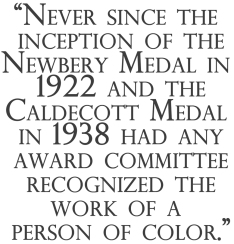 The year was 1969. Two librarians walking through the exhibit hall stopped by a booth where a poster of the late Martin Luther King Jr. was on display. This was the start of a genial conversation that evolved into the observation that never since the inception of the Newbery Medal in 1922 and the Caldecott Medal in 1938 had any award committee recognized the work of a person of color.
The year was 1969. Two librarians walking through the exhibit hall stopped by a booth where a poster of the late Martin Luther King Jr. was on display. This was the start of a genial conversation that evolved into the observation that never since the inception of the Newbery Medal in 1922 and the Caldecott Medal in 1938 had any award committee recognized the work of a person of color.
John Carroll, a publisher from a small company in New York, overheard the conversation. It was reported that he said, rather matter of factly, “Then why don’t you ladies establish your own award?” The seed was planted. Before the conference ended, in an informal meeting on the boardwalk in Atlantic City under the leadership of Glyndon Greer and Mabel McKissick, the idea of a award for African American authors was shared with a group of African American librarians, including Augusta Baker, Charlemae Rollins, Ella Mae Yates, and Virginia Lacy Jones, to name a few. At this seaside gathering, the struggle for recognition began.
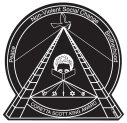 The ALA questioned the need for another award. A majority of publishers informed the committee that they did not have enough children’s books by African Americans to provide for evaluation. And many librarians were skeptical of anything becoming of this fragile brainchild. Undaunted and unconvinced that this venture was fruitless, the committee moved on. In 1970, the first Coretta Scott King Awards breakfast was scheduled in a hotel that just “happened” not to be on the ALA list of official hotels. After a meager meal and short program, the first recipient of the Coretta Scott King Award was announced. A school librarian from New Jersey, Lillie Patterson, went down in history as the first winner of the award for her elementary level biography, Martin Luther King, Jr.: Man of Peace.
The ALA questioned the need for another award. A majority of publishers informed the committee that they did not have enough children’s books by African Americans to provide for evaluation. And many librarians were skeptical of anything becoming of this fragile brainchild. Undaunted and unconvinced that this venture was fruitless, the committee moved on. In 1970, the first Coretta Scott King Awards breakfast was scheduled in a hotel that just “happened” not to be on the ALA list of official hotels. After a meager meal and short program, the first recipient of the Coretta Scott King Award was announced. A school librarian from New Jersey, Lillie Patterson, went down in history as the first winner of the award for her elementary level biography, Martin Luther King, Jr.: Man of Peace.

from Ray Charles
It was not until 1974 that the award breakfast was held in an ALA conference site, but even then, the CSK Award was not recognized as an official ALA award, nor was the award committee recognized as an official ALA body. But to the joy of all, publishers were now sending more quality books, and attendance at the 7:30 a.m. breakfast was steadily growing! Another change came in 1974 when the committee presented its first illustrator award. George Ford, who is still painting today, won for the illustrations he created for Sharon Bell Mathis’ biography Ray Charles.
In the years that followed, a major breakthrough came when E. J. Josey was elected president of the ALA. One of his first concerns was to bring the Coretta Scott King Committee into the official folds of the American Library Association. In 1980, the Coretta Scott King Committee became the Coretta Scott King Task Force, a viable part of Social Responsibilities Task Force (since 1993 a part of EMIERT), with founder Glyndon Greer as its first chair.
Growth and changes can be seen as the benchmark of this dynamic group of librarians. Artist Lev Mills designed the medal that is placed on each award-winning book. The symbols in the medal’s design each carry a special message; even the colors of the winner and honor book medals, and the more recent new talent award medal, have significance. The monetary prize for the winners was first given through the efforts of the late Basil O. Phillips of the Johnson Publishing Company, and today the encyclopedias from Britannica and World Book have moved from print into the digital age.
Following negotiations with the ALA parent body on Awards and Recognitions, and the late John Steptoe’s son, illustrator Javaka Steptoe, in 1995, the New Talent Award was established. It was named in honor of John Steptoe, whose first book, Stevie (1969), won national acclaim when the author/illustrator was only nineteen years of age.
With each meeting of the Coretta Scott King Task Force, new ideas for growth are on the docket. Among the newest is the Coretta Scott King/Virginia Hamilton Award for Lifetime Achievement, which goes to an African American author, illustrator, author/illustrator, or practitioner (such as a librarian) for his or her body of work or contributions to reading programs involving African American literature. Changes are constantly in the works too. New ideas for creating greater visibility and wider use of Coretta Scott King Award books and materials are a part of every Task Force meeting.
To think that all this started with a meeting on the boardwalk in Atlantic City! The very spot may not be there now, but surely the news reports about Hurricane Sandy conjured up many of these same memories for those who met on the boardwalk way back in 1969.
Dr. Henrietta M. Smith, native New Yorker, received her MLS degree from Columbia University and EdD from University of Miami, Florida. She teaches in the Materials for Youth in the School of Information (University of South Florida, Tampa, Florida). Longtime member of the ALA, Smith has served on Newbery Caldecott, Wilder (Chair), and Pura Belpré Award committees for ALSC and has chaired the Coretta Scott King Task Force and the CSK Award Committee. Smith received the ALSC Distinguished Service Award in 2008 and in 2011 was the first practitioner recipient of the Coretta Scott King/Virginia Hamilton Award for Lifetime Achievement in Librarianship.
Filed under:
guest blogger,
Musings & Ponderings,
Publishing 101,
Resources Tagged:
African American history,
African/African American Interest,
american library association,
awards,
black history month,
coretta scott king awards,
Why I Love Librarians 

 Since it’s apparently football season (or at least that’s what the trending topics on Twitter seem to imply) think of this as a kind of post-game recap of what went on yesterday in the land of ALA Media Awards. Each year I like to look at what I got right, what I got wrong, what I got horrendously wrong, and what I got so wrong that it’s a miracle I’m even allowed to blog anymore. And because I believe in eating my cake before my dinner, we’ll start at the top and work our way down (metaphorically speaking).
Since it’s apparently football season (or at least that’s what the trending topics on Twitter seem to imply) think of this as a kind of post-game recap of what went on yesterday in the land of ALA Media Awards. Each year I like to look at what I got right, what I got wrong, what I got horrendously wrong, and what I got so wrong that it’s a miracle I’m even allowed to blog anymore. And because I believe in eating my cake before my dinner, we’ll start at the top and work our way down (metaphorically speaking).
First up:
Newbery Winners: I Got Them Moves Like Gantos
When I posted my review of The Great Cake Mystery yesterday and happened to include at the end an image of Dead End in Norvelt: British Edition (called just plain old Dead End and shown here) I hadn’t even considered the possibility that the darn book was poised to win the greatest honor in the field of children’s literature. Why had I recovered from my Gantos fever? Well, I think Jon Scieszka put it best yesterday when he tweeted his congrats to Jack and applied the hashtag #afunnybookfinallywins. Ye gods. He’s right. I ran over to ye olde list of past Award winners and while some contain elements of humor, none of them have been as outright ballsy in their funny writing as Gantos was here. I mean, you can make a case for Despereaux or Bud Not Buddy if you want, but basically even those books drip of earnestness. And on some level I must have figured the funny book couldn’t win. I had forgotten myself the moniker I had applied to this year. The Year of Breaking Barriers. Well if giving a big award to a funny title isn’t breaking a barrier here or there, I don’t know what is.
It’s really funny to read my mid-year and fall predictions in regards to the Gantos title. In the middle of the year I mentioned the book as a possibility but even then I wasn’t putting too much hope there. I wrote:
This is undoubtedly wishful thinking on my part. Gantos has never gotten the gold, and he deserves it someday. This book, of course, has a weird undercurrent to it that may turn off a certain breed of Newbery committee member. Not everyone is going to find Jack’s constant brushes with death as interesting as I do. Still, I hold out hope that maybe this’ll be a Gantos-luvin’ committee year. Stranger things have happened.
Stranger indeed. By the fall I was mentioning it, but only in passing and with the feeling that it was an unlikely bet so that by my last prediction it had fallen off the radar entirely.

 'Tis the season for award announcements, and I am happy to tell you that Bad News for Outlaws: The remarkable life of Bass Reeves, Deputy U.S. Marshal won the 2010 Coretta Scott King award. The book would make a great title for children studying the real Wild West and Black History Month. Here is my review:
'Tis the season for award announcements, and I am happy to tell you that Bad News for Outlaws: The remarkable life of Bass Reeves, Deputy U.S. Marshal won the 2010 Coretta Scott King award. The book would make a great title for children studying the real Wild West and Black History Month. Here is my review:
Bad news for outlaws: The remarkable life of Bass Reeves, Deputy U.S. Marshall
Vaunda Micheaux Nelson
Illustrated by R. Gregory Christie
Nonfiction Picture Book
Ages 8 to 10
Lerner, 2009, 0822567644
Bass Reeves was born into slavery in Arkansas in 1838, and he grew up on a plantation in Texas where he took care of the animals, fetched water, and learned how to become a crack shot. Bass was such a favorite with his master, Colonel George Reeves, that his master took Bass with him into battle when the Civil War broke out. During an argument, Bass struck his master, and knowing that this was a death sentence for a slave, Bass ran away to live with Native Americans in Indian Territory.
When the Civil War was over and he was free, Bass settled down, got married, and he and his wife had children. Bass was happy living in Indian Territory but then the area “became a haven for the West’s most notorious outlaws.” Judge Isaac C. Parker was sent to the territory, and he hired two hundred deputy marshals to help bring law and order back to the land. Bass was one of these deputy marshals, and he took his job very seriously, bringing in the outlaws he was sent to catch without resorting to undue violence. He was incorruptible, determined, and “as honest as the day was long.”
In this fascinating picture book, Vaunda Micheaux Nelson beautifully tells the story of one of the West’s unsung heroes. Unlike many Wild West legends, this story is true. With gripping accounts of Bass Reeves’ exploits, the author keeps the reader engaged right to the last page.
Here is some information about the author and the illustrator:
About the Author:
Vaunda Micheaux Nelson is the author of numerous fiction and nonfiction books for children, including Almost to Freedom, which received 2004 Coretta Scott King Illustration Honor Award. In addition to writing books, she has also been a teacher, newspaper reporter, bookseller, and school librarian. She lives in Rio Rancho,
New Mexico.
Last week, at a lunch meeting of the Children’s Book Guild of Washington, D.C., I had the pleasure of hearing Andrea Davis Pinkney, honorary co-chair of the 40th birthday celebration of the Coretta Scott King (CSK) Book Awards, and Deborah Taylor, the current chair of the award committee, talk about the history and winners of these prestigious awards, which recognize outstanding children’s books by African American authors and illustrators. Pinkney, a vice president and executive editor at Scholastic, received a 2001 CSK author award for her book Let It Shine! Stories of Black Women Freedom Fighters. Taylor is coordinator for School and Student Services for the Enoch Pratt Free Library in Baltimore. Both women are passionate about the awards, which Taylor credits with bringing “deserving children’s book authors and illustrators to greater public attention, while inspiring new writers and artists to enter the field.”
Taylor noted that in 1985, only 18 out of the 2,500 children’s books published in the United States were eligible for the Coretta Scott King Book Awards. By 2008, that number had grown to 83 books. Taylor is most proud that the awards have helped to boost the careers of several young authors and illustrators, including Kadir Nelson, whose fascinating history of Negro League Baseball, We Are the Ship, was this year’s CSK Author Award Winner and a CSK Illustrator Honor Book. It also won the 2009 Sibert Award, making it the first book to claim both CSK and Sibert awards.

Nelson was a special guest at the Guild lunch, along with author Sharon Robinson, the daughter of baseball pioneer and American hero Jackie Robinson. They brought along their brand new picture book, Testing the Ice: A True Story About Jackie Robinson (Scholastic Press), which Sharon wrote and Nelson illustrated.
In an engaging first-person narrative, Robinson tells a story from her childhood that interweaves family lore with civil rights history—and is also a metaphor for her father’s legendary breaking of the color barrier in major league baseball. She starts with the year 1955, when the Robinson family moved to Connecticut. Sharon and her two brothers and their new neighborhood friends enjoy swimming and boating on the lake on their property, but her father always keeps his distance from the water. When the youngsters play inside the Robinsons’ house, they get Jackie talking about his historic career.
That first winter the lake freezes, and the Robinson kids beg their dad to let them go ice-skating. He agrees, but makes them wait while he tests the ice. With a shovel in one hand and a broomstick in the other, he inches out onto the snow-covered ice. In a flash of understanding, Sharon understands why she's never seen her dad in the water—he doesn't know how to swim. As she watches in fear, he taps his way to the center of the lake, then calls out, “It’s safe! Put on your skates!” The children cheer and Sharon thinks, “My dad is the bravest man alive.”
Nelson’s radiant paintings are magnetic. The baseball scenes throb with muscular energy and the family scenes glow with warmth. Many of the family scenes are based on Jackie Robinson’s personal family photographs. In one of my favorite spreads, we see the back of Jackie’s head and in front of him the rapt faces of his kids and their friends as he tells them the story of his entry into major league baseball, how he had to struggle to keep his temper from exploding amid the insults being hurled at him, and how sweet the victory was when he stole home in one especially tough game. I felt like I was one of those kids looking up at him, and I bet young readers will, too. This book is an inviting introduction to the man whose talent, courage, and perseverance on and off the field made him a hero to Americans of all colors.

















Very important question: do you and Jon just travel with spare red tuxes all the time? I feel like more backstory is needed here!
There’s an explanation all right!
Jon was slated to co-host the Children’s Book Choice Book Awards Gala alongside Oliver Jeffers. Then Mr. Jeffers has a clash of commitments (Bono needed him) so that meant Jon was left with a spare purple tux. He’d bought two, you see, and needed a co-host. And who likes purple tuxes (besides The Joker)? Me! So I got to co-host and somehow Jon, in his infinite charm and wisdom, managed to convinced Matt to wear a red version.
It was a good night.
I always love your round-ups, Betsy! And by the way, I happen to know that Pam herself can play a mean harmonica, so who knows what may happen at that banquet.
Great photo and I’m sure it was a great time – awesome tuxes!! I really appreciated the diversity in the selection process, and I’m particularly pointing out the novelty of the honorees and winners. Picture books with a deeper message, novels with graphic intensity and style, government secrets laid thread-bare, music and politics, personal memoirs. I’ve enjoyed your wrap-up column, with all it’s thoroughness – as usual! Thanks!